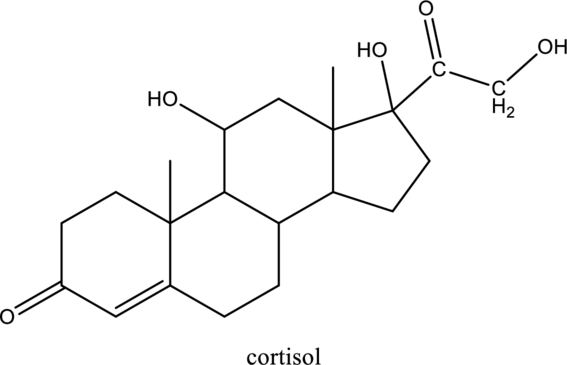
Interpretation:
Product formed when below alcohol is oxidized in presence of K2Cr2O7 has to be determined

Concept introduction:
Oxidation of alcohol:
During oxidation of alcohol, the number of
Want to see the full answer?
Check out a sample textbook solution
Chapter 12 Solutions
Principles of General, Organic, Biological Chemistry
- Give the general classification of each compound.(a) glyceryl tripalmitatearrow_forwardBile salts are derivative of cholestrol. However, the solubilities of these compounds in water are drastically different; cholestrol is highly hydrophobic, and the bile salts are soluble in digestive juices. Explain the differences.arrow_forwardIdentify which substance is oxidized and which is reduced in the following reaction. OH H2 cyclohexanone cyclohexanol Oxidized: cyclohexanone Reduced: cyclohexanolarrow_forward
- What happens when phenol is oxidized by Na2Cr2O7/H2SO4?arrow_forwardConsider the following two molecules and answer the following questions. Molecule A: HO- CH-CH3 CH3 Molecule B: || H,C-CH,-C-0-CH3 a) What are all of the IMFS present in molecule A? b) What are all of the IMFS present in molecule B? c) Which would have the higher boiling point, molecule A or molecule B? d) What is the relationship between molecules A & B: structural isomers, geometric isomers, identical, or not related?arrow_forwardCodeine can treat pain and cough but has a high risk for addiction and dependence. Which of the following statements about Codeine is false? H3C H- N-CH3 HO O The methoxy group masks an important binding group O The structure is converted to morphine in the brain O The structure is a weaker analgesic than morphine. O The structure acts as a prodrugarrow_forward
- 18-41 Complete these examples of Fischer esterification. In each case, assume an excess of the alcohol.arrow_forwardDigitalis is a preparation made from the dried seeds and leaves of the purple foxglove, Digitalis purpurea, a plant native to southern and central Europe and cultivated in the United States. The preparation is a mixture of several active components, including digitalin. Digitalis is used in medicine to increase the force of myocardial contraction and as a conduction depressant to decrease heart rate (the heart pumps more forcefully but less often).arrow_forward18-18 Propanoic acid and methyl acetate are constitutional isomers, and both are liquids at room temperature. One of these compounds has a boiling point of 141°C; the other has a boiling point of 57°C. Which compound has which boiling point? Explain.arrow_forward
 Introduction to General, Organic and BiochemistryChemistryISBN:9781285869759Author:Frederick A. Bettelheim, William H. Brown, Mary K. Campbell, Shawn O. Farrell, Omar TorresPublisher:Cengage Learning
Introduction to General, Organic and BiochemistryChemistryISBN:9781285869759Author:Frederick A. Bettelheim, William H. Brown, Mary K. Campbell, Shawn O. Farrell, Omar TorresPublisher:Cengage Learning Organic And Biological ChemistryChemistryISBN:9781305081079Author:STOKER, H. Stephen (howard Stephen)Publisher:Cengage Learning,
Organic And Biological ChemistryChemistryISBN:9781305081079Author:STOKER, H. Stephen (howard Stephen)Publisher:Cengage Learning, General, Organic, and Biological ChemistryChemistryISBN:9781285853918Author:H. Stephen StokerPublisher:Cengage Learning
General, Organic, and Biological ChemistryChemistryISBN:9781285853918Author:H. Stephen StokerPublisher:Cengage Learning Macroscale and Microscale Organic ExperimentsChemistryISBN:9781305577190Author:Kenneth L. Williamson, Katherine M. MastersPublisher:Brooks Cole
Macroscale and Microscale Organic ExperimentsChemistryISBN:9781305577190Author:Kenneth L. Williamson, Katherine M. MastersPublisher:Brooks Cole Chemistry for Today: General, Organic, and Bioche...ChemistryISBN:9781305960060Author:Spencer L. Seager, Michael R. Slabaugh, Maren S. HansenPublisher:Cengage LearningChemistry: Matter and ChangeChemistryISBN:9780078746376Author:Dinah Zike, Laurel Dingrando, Nicholas Hainen, Cheryl WistromPublisher:Glencoe/McGraw-Hill School Pub Co
Chemistry for Today: General, Organic, and Bioche...ChemistryISBN:9781305960060Author:Spencer L. Seager, Michael R. Slabaugh, Maren S. HansenPublisher:Cengage LearningChemistry: Matter and ChangeChemistryISBN:9780078746376Author:Dinah Zike, Laurel Dingrando, Nicholas Hainen, Cheryl WistromPublisher:Glencoe/McGraw-Hill School Pub Co





